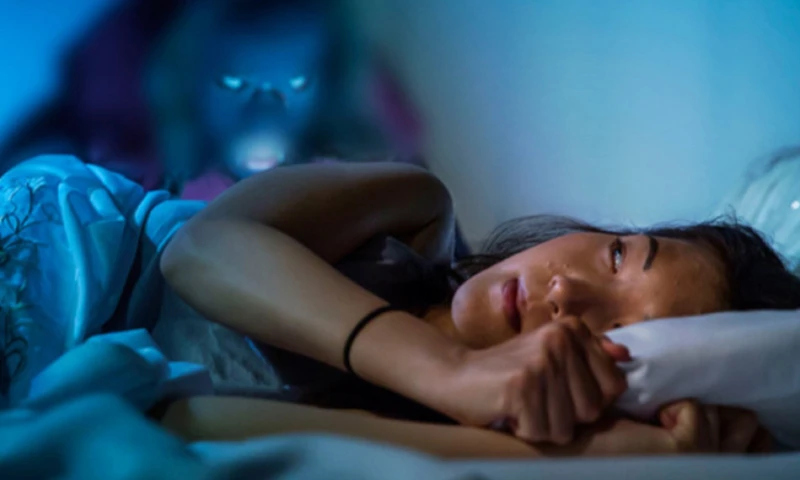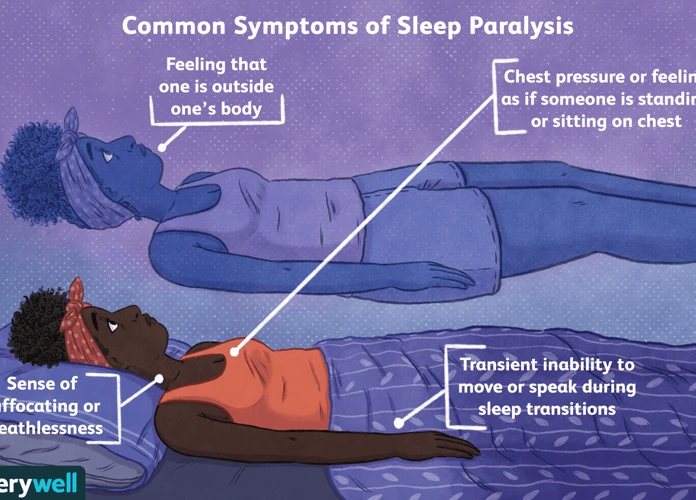Sleep Paralysis in Children: Causes, Risks, and Management – Imagine waking up in the middle of the night, unable to move or speak, while experiencing vivid hallucinations and a overwhelming sense of fear. This unsettling phenomenon is known as sleep paralysis, and it can be particularly distressing for children. In this article, we will delve into the causes of sleep paralysis in children, the risks and effects it can have on their well-being, and practical strategies for managing and preventing this sleep disorder. By understanding the underlying factors and implementing appropriate measures, parents and caregivers can help alleviate the distressing symptoms of sleep paralysis and promote healthier sleep patterns for their children.
Understanding Sleep Paralysis

What is sleep paralysis? Sleep paralysis is a temporary inability to move or speak that occurs when a person is transitioning between sleep and wakefulness. During this episode, the individual is fully aware of their surroundings, but their voluntary muscles become paralyzed, leaving them unable to move or scream for help. These episodes often last for a few seconds to a few minutes, but can be incredibly frightening and disturbing for those experiencing them. Sleep paralysis is more common in children than many people may realize, and understanding its causes, symptoms, and management is crucial for parents and caregivers. For a more in-depth exploration of the science behind sleep paralysis, you can check out this informative article that provides a detailed understanding of the phenomenon.
What is Sleep Paralysis?
Sleep paralysis is a sleep disorder characterized by a temporary inability to move or speak while transitioning between sleep and wakefulness. It is a phenomenon that occurs during the REM (rapid eye movement) stage of sleep, which is when most vivid dreaming takes place. During sleep paralysis, the brain disconnects the voluntary muscles from the signals it sends, essentially rendering them temporarily paralyzed. This paralysis is a natural safety mechanism that prevents us from acting out our dreams and potentially causing harm to ourselves or others. However, in sleep paralysis, this mechanism is triggered while the person is awake or in the process of waking up. As a result, individuals may find themselves fully conscious and aware of their surroundings but unable to move their body or speak. This can be an incredibly unsettling experience, often accompanied by intense feelings of fear and helplessness. To learn more about the causes, symptoms, and treatment of sleep paralysis, you can refer to this detailed article that provides a comprehensive understanding of this sleep disorder. It is important to note that sleep paralysis is not harmful in itself, but it can be distressing and disruptive to an individual’s sleep and overall well-being. By gaining a deeper understanding of sleep paralysis, we can work towards managing its effects and alleviating the fear and confusion it may cause.
Sleep Paralysis in Children
Sleep paralysis in children refers to the occurrence of sleep paralysis episodes specifically in the pediatric population. It is important to note that sleep paralysis can affect individuals of all ages, including children. While the exact prevalence of sleep paralysis in children is not well-established, studies suggest that it may be more common than previously thought. Children who experience sleep paralysis often describe feelings of fear and helplessness during these episodes. It is essential for parents and caregivers to understand that sleep paralysis in children is usually not indicative of any underlying medical condition or serious health risk. However, it can be distressing for the child and may disrupt their sleep patterns. By debunking myths and misconceptions surrounding sleep paralysis, which you can learn more about in this helpful article, parents can provide reassurance and support to their children who may be experiencing this phenomenon.
Causes of Sleep Paralysis in Children

Several factors can contribute to the occurrence of sleep paralysis in children. Here are some of the most common causes:
1. Sleep Deprivation: Inadequate sleep or irregular sleep patterns can increase the likelihood of experiencing sleep paralysis episodes. Children who consistently lack the recommended amount of sleep are more susceptible to disruptions in their sleep-wake cycle, which can trigger sleep paralysis.
2. Irregular Sleep Schedule: Going to bed at different times each night or having an irregular sleep routine can disrupt the body’s natural sleep patterns, making children more prone to sleep paralysis.
3. Stress and Anxiety: Emotional stress and anxiety can contribute to the occurrence of sleep paralysis in children. Factors such as school pressures, family issues, or traumatic events can increase the likelihood of experiencing sleep paralysis episodes.
Understanding these causes can help parents and caregivers identify potential triggers and take steps to prevent or manage sleep paralysis in children. It is essential to address these underlying factors and create a supportive sleep environment to promote healthy sleep patterns.
1. Sleep Deprivation
Sleep deprivation is a common cause of sleep paralysis in children. When children do not get enough sleep on a regular basis, it can disrupt their sleep cycles and lead to episodes of sleep paralysis. The lack of adequate sleep can result from various factors such as school-related activities, extracurricular commitments, electronic device usage, or even medical conditions that interfere with sleep. It is important for parents to ensure that their children are getting the recommended amount of sleep for their age group. According to the American Academy of Sleep Medicine, school-age children (6-12 years old) should aim for 9-12 hours of sleep per night, while teenagers (13-18 years old) should aim for 8-10 hours. Implementing a consistent bedtime routine and creating a sleep-friendly environment can help promote healthier sleep habits and reduce the likelihood of sleep deprivation, thus decreasing the occurrence of sleep paralysis.
2. Irregular Sleep Schedule
Irregular sleep schedules can contribute to the occurrence of sleep paralysis in children. When children do not have a consistent sleep routine, their bodies may struggle to regulate their sleep-wake cycles effectively. This can disrupt the normal transition between different stages of sleep and increase the likelihood of experiencing sleep paralysis episodes. Additionally, irregular sleep patterns can lead to sleep deprivation, which is another factor associated with sleep paralysis. When children do not get enough sleep or have inconsistent sleep patterns, their sleep quality can suffer, making them more susceptible to sleep paralysis. It is essential for parents and caregivers to prioritize establishing a regular sleep schedule for children, ensuring that they have consistent bedtimes and wake-up times. This consistency helps synchronize their internal sleep-wake rhythm and reduces the risk of experiencing sleep paralysis.
3. Stress and Anxiety
Stress and anxiety can be significant contributors to sleep paralysis in children. When children experience high levels of stress or anxiety, it can disrupt their sleep patterns and make them more prone to sleep paralysis episodes. Stressful events such as exams, family conflicts, or changes in routine can trigger increased anxiety in children, leading to heightened arousal during sleep and a greater likelihood of experiencing sleep paralysis. Additionally, children who have pre-existing anxiety disorders or are naturally more anxious may be at a higher risk for sleep paralysis. It is important for parents and caregivers to create a supportive and calming environment for children, as well as teach them effective coping mechanisms to manage stress and anxiety. Regular communication, relaxation techniques, and engaging in enjoyable activities can help reduce stress levels and alleviate the occurrence of sleep paralysis episodes related to stress and anxiety.
Risks and Effects of Sleep Paralysis in Children

Sleep paralysis in children can have several risks and effects that impact their overall well-being. Firstly, it can lead to psychological distress, causing feelings of fear and anxiety, especially when they are unaware of what is happening to them. This can lead to sleep disruption and contribute to a vicious cycle of poor sleep quality and increased anxiety. Secondly, sleep paralysis can have a significant impact on their sleep quality, resulting in disrupted sleep patterns and frequent awakenings during the night. This can lead to daytime fatigue, difficulty concentrating, and reduced cognitive performance. Lastly, the experience of sleep paralysis can be physically and emotionally draining for children, leaving them feeling exhausted and irritable. It is important for parents and caregivers to recognize these risks and effects, and take proactive steps to manage and minimize the impact of sleep paralysis on their children’s well-being.
1. Psychological Distress
Psychological distress is one of the significant risks and effects associated with sleep paralysis in children. Experiencing sleep paralysis episodes can have a profound impact on a child’s mental well-being. The intense feelings of fear, helplessness, and confusion that accompany these episodes may lead to psychological distress, such as anxiety and depression. Children may develop a fear of going to sleep or develop insomnia due to the fear of experiencing sleep paralysis again. Additionally, the vivid hallucinations that often accompany sleep paralysis can be extremely distressing for children, causing them to feel scared and anxious even when they are awake. It is crucial for parents and caregivers to provide emotional support and reassurance to children who experience sleep paralysis, helping them understand that these episodes are a temporary condition and not a sign of any underlying mental illness.
2. Impact on Sleep Quality
When it comes to sleep paralysis in children, one of the significant risks is the impact it can have on their sleep quality. Here are some key points to consider:
– Disrupted Sleep Patterns: Sleep paralysis episodes can occur during different stages of sleep, such as during the transition from REM (rapid eye movement) sleep to waking up. These episodes can disrupt the child’s sleep patterns, causing them to wake up abruptly and feel groggy or fatigued upon awakening.
– Fragmented Sleep: Sleep paralysis can lead to fragmented sleep, where the child’s sleep is interrupted multiple times throughout the night. This can result in a lack of restorative and uninterrupted sleep, which is essential for their overall well-being and development.
– Sleep Disturbances: The fear and anxiety associated with sleep paralysis can lead to sleep disturbances. Children may develop a fear of going to sleep, anticipating another episode of paralysis. This fear can further disrupt their ability to fall asleep and stay asleep throughout the night.
– Sleep-Related Disorders: Sleep paralysis is often associated with other sleep disorders, such as insomnia or sleep apnea. The presence of sleep paralysis can exacerbate these conditions, leading to further sleep disturbances and a negative impact on the child’s overall sleep quality.
Understanding the impact of sleep paralysis on sleep quality is vital for parents and caregivers. By addressing these effects, implementing effective management strategies, and promoting healthy sleep habits, we can help improve sleep quality and overall well-being for children experiencing sleep paralysis.
3. Daytime Fatigue
Daytime fatigue is a common consequence of sleep paralysis in children. When children experience sleep paralysis episodes during the night, it can disrupt their sleep and prevent them from getting the restorative rest they need. As a result, they may feel excessively tired and fatigued during the day. This can have a significant impact on their overall well-being, as it can affect their ability to concentrate, learn, and perform well in school. Daytime fatigue can also lead to irritability and mood swings in children, making it challenging for them to engage in daily activities and interact with their peers. It is essential for parents and caregivers to recognize the connection between sleep paralysis and daytime fatigue and take steps to address the root causes of sleep paralysis to alleviate its impact on their child’s energy levels and daily functioning. By implementing effective management strategies and promoting healthy sleep habits, parents can help their children overcome the daytime fatigue associated with sleep paralysis.
Management and Prevention of Sleep Paralysis in Children
Managing and preventing sleep paralysis in children is essential to ensure their well-being and promote healthy sleep patterns. Here are some practical strategies that can be implemented:
1. Maintaining a regular sleep schedule: Establishing a consistent bedtime routine and sticking to a regular sleep schedule can help regulate the body’s internal clock and promote better quality sleep.
2. Creating a relaxing bedtime routine: Engaging in calming activities before bed, such as reading or listening to soft music, can help reduce stress and anxiety, making it easier for children to fall asleep.
3. Minimizing stress and anxiety: Encouraging open communication with children and addressing any underlying stressors or anxieties can help alleviate the triggers of sleep paralysis.
4. Promoting healthy sleep hygiene: Encouraging a sleep-friendly environment, including a comfortable mattress, appropriate room temperature, and minimizing distractions, can contribute to a better sleep experience.
5. Seeking professional help: If sleep paralysis episodes persist or significantly impact a child’s well-being, it is important to consult a healthcare professional or sleep specialist for further evaluation and guidance. By implementing these strategies, parents and caregivers can help manage and prevent sleep paralysis in children, contributing to their overall sleep health and quality of life.
1. Maintaining a Regular Sleep Schedule
Maintaining a regular sleep schedule is essential for managing sleep paralysis in children. Consistency in bedtime and wake-up time helps regulate their internal body clock and promotes healthy sleep patterns. Establishing a routine that aligns with their natural sleep-wake cycle can significantly reduce the occurrence of sleep paralysis episodes. It is recommended to encourage children to go to bed and wake up at the same time every day, even on weekends or during holidays. This consistency reinforces their body’s sleep-wake rhythm and minimizes the disruption to their sleep schedule. Additionally, it is important to ensure that children are getting an adequate amount of sleep for their age. The National Sleep Foundation recommends that school-aged children (6-13 years old) get 9-11 hours of sleep per night, while teenagers (14-17 years old) need 8-10 hours. By prioritizing a regular sleep schedule and providing enough time for quality sleep, parents can help reduce the likelihood of sleep paralysis in their children.
2. Creating a Relaxing Bedtime Routine
Creating a relaxing bedtime routine is essential for children who experience sleep paralysis. A consistent routine can help signal to the body and mind that it is time to wind down and prepare for sleep. Here are some tips to incorporate into a bedtime routine:
1. Avoid stimulating activities: Encourage children to engage in calm and relaxing activities before bed, such as reading a book, listening to soothing music, or practicing gentle stretching or yoga.
2. Create a calm environment: Make sure the bedroom is comfortable and conducive to sleep. Keep the room dark, quiet, and at a cool temperature. Consider using blackout curtains, white noise machines, or soothing scents, like lavender, to promote relaxation.
3. Establish a consistent sleep schedule: Set a regular bedtime and wake-up time, even on weekends. Consistency helps regulate the body’s internal clock and promote better sleep quality.
4. Limit screen time: Discourage the use of electronic devices, such as smartphones, tablets, and TVs, before bed as the blue light emitted by screens can interfere with the body’s natural sleep-wake cycle. Encourage children to disconnect from technology at least an hour before bedtime.
5. Promote relaxation techniques: Teach children calming techniques like deep breathing exercises, progressive muscle relaxation, or guided imagery. These can help reduce stress and anxiety, preparing them for a more restful sleep.
By incorporating these practices into a bedtime routine, parents can create a peaceful atmosphere that promotes better sleep quality and alleviates the occurrence of sleep paralysis episodes in children.
3. Minimizing Stress and Anxiety
Stress and anxiety can exacerbate sleep paralysis episodes in children, so minimizing these factors is crucial for their management. Here are some strategies for helping children reduce stress and anxiety:
1. Create a Calm and Supportive Environment: Providing a calm and supportive environment at home can greatly help in reducing stress and anxiety. Encourage open communication and create a safe space where children feel comfortable expressing their emotions and concerns. Establishing a predictable routine and setting clear expectations can also contribute to a sense of stability and ease stress.
2. Teach Relaxation Techniques: Teach children simple relaxation techniques that can help them calm their minds and bodies before bed. Deep breathing exercises, progressive muscle relaxation, and guided imagery can all be effective in reducing stress and anxiety. Encourage your child to practice these techniques regularly to build resilience and manage anxiety in their daily lives.
3. Encourage Physical Activity: Regular physical activity has been shown to reduce stress and anxiety levels in children. Encourage your child to engage in activities they enjoy, such as playing sports, dancing, or going for walks. Physical activity not only reduces stress but also promotes better sleep quality, helping to minimize the occurrence of sleep paralysis episodes.
4. Limit Exposure to Stressful Situations: Identify potential sources of stress in your child’s life and take steps to minimize their exposure to them. This could include reducing excessive academic pressure, limiting screen time, and avoiding stimulating activities close to bedtime. Creating a calm and quiet environment in the evening can help children unwind and relax before sleep.
5. Foster Healthy Coping Mechanisms: Teach your child healthy coping mechanisms to deal with stress and anxiety. This could involve encouraging them to express their feelings through art, writing, or talking to a trusted adult. Teach them problem-solving skills and positive self-talk to help them navigate stressful situations with confidence.
By implementing these strategies and taking a proactive approach to minimize stress and anxiety, parents can help reduce the frequency and intensity of sleep paralysis episodes in children. Remember that each child is unique, so finding what works best for your child may require some experimentation and adjustments along the way.
4. Promoting Healthy Sleep Hygiene
Promoting healthy sleep hygiene is essential in managing and preventing sleep paralysis in children. Here are some practical strategies to incorporate into their daily routine:
1. Establish a Consistent Bedtime Routine: A consistent bedtime routine helps signal to the body that it’s time to wind down and prepare for sleep. Encourage activities such as reading a book, taking a warm bath, or practicing relaxation techniques like deep breathing or meditation.
2. Create a Relaxing Sleep Environment: Ensure that your child’s sleep environment is calm, comfortable, and conducive to sleep. Keep the bedroom cool, quiet, and dark, and consider using white noise machines or blackout curtains to minimize distractions.
3. Limited Technology Use: Electronic devices emit blue light, which can interfere with the body’s natural sleep-wake cycle. Set limits on screen time before bedtime and encourage children to engage in relaxing activities instead, such as listening to calming music or engaging in light stretching exercises.
4. Encourage Regular Exercise: Regular physical activity during the day can help promote better sleep at night. Encourage your child to engage in age-appropriate exercise, such as riding a bike, playing outside, or participating in sports.
5. Monitor Caffeine and Sugar Intake: Limit your child’s consumption of caffeine and sugary foods or beverages, especially before bedtime. These substances can interfere with sleep quality and make it harder for children to fall asleep or stay asleep.
By incorporating these healthy sleep habits into your child’s routine, you can create a conducive environment for quality sleep and reduce the likelihood of sleep paralysis episodes. Remember that consistency is key when it comes to promoting healthy sleep hygiene, so try to maintain these practices consistently to establish a healthy sleep routine for your child.
5. Seeking Professional Help
If your child continues to experience sleep paralysis despite implementing various management strategies, it may be beneficial to seek professional help. Consulting with a healthcare professional, such as a pediatrician or a sleep specialist, can provide valuable insights and guidance tailored to your child’s specific situation. These professionals have the expertise and knowledge to assess underlying factors contributing to sleep paralysis and offer appropriate treatment options. They may recommend therapies such as cognitive-behavioral therapy (CBT) or prescribe medication if necessary. Additionally, they can address any concerns or questions you may have regarding your child’s sleep disorder, providing reassurance and support throughout the process. Remember, seeking professional help is an important step in ensuring your child’s overall well-being and improving their quality of sleep.
Conclusion
In conclusion, sleep paralysis in children can be a distressing and unsettling phenomenon, but with the right knowledge and strategies, it can be managed and even prevented. By maintaining a regular sleep schedule, creating a relaxing bedtime routine, minimizing stress and anxiety, promoting healthy sleep hygiene, and seeking professional help if needed, parents and caregivers can help alleviate the symptoms and effects of sleep paralysis in children. It is important to remember that each child is unique, and what works for one may not work for another, so patience and persistence are key. By addressing the underlying causes, such as sleep deprivation, irregular sleep schedules, and stress, and implementing effective management techniques, parents can help their children regain control of their sleep and improve their overall well-being. With proper understanding and support, sleep paralysis can become a manageable aspect of a child’s life, allowing them to enjoy restful and rejuvenating sleep.
Frequently Asked Questions
1. What triggers sleep paralysis in children?
Sleep paralysis in children can be triggered by various factors, including sleep deprivation, irregular sleep schedules, and heightened stress or anxiety levels.
2. Is sleep paralysis in children dangerous?
No, sleep paralysis itself is not dangerous. However, the experience can be distressing for children and may impact their overall sleep quality and well-being.
3. Can sleep paralysis cause long-term psychological effects in children?
While sleep paralysis itself does not typically cause long-term psychological effects, the distressing nature of the experience can contribute to increased anxiety or fear of falling asleep among children.
4. Can a regular sleep schedule help prevent sleep paralysis in children?
Yes, maintaining a regular sleep schedule is important for preventing sleep paralysis in children. Consistent bedtimes and wake-up times can help regulate their sleep cycles and reduce the likelihood of experiencing sleep paralysis episodes.
5. Does stress play a role in sleep paralysis episodes?
Yes, stress can play a significant role in triggering sleep paralysis episodes. Managing stress and anxiety levels through relaxation techniques and stress-reducing activities can help minimize the occurrence of sleep paralysis in children.
6. Are there any medications specifically designed to treat sleep paralysis in children?
No, there are no specific medications designed to treat sleep paralysis in children. However, addressing underlying sleep issues and implementing healthy sleep practices can help alleviate the frequency and severity of sleep paralysis episodes.
7. Can sleep paralysis be inherited?
There is some evidence to suggest that sleep paralysis may have a genetic component, meaning it can run in families. However, more research is needed to fully understand the genetic factors involved in sleep paralysis.
8. How can parents help their children cope with sleep paralysis?
Parents can provide reassurance and support to their children during sleep paralysis episodes. It is important to educate children about the condition, create a comforting bedtime routine, and encourage open communication to help alleviate any fears or anxieties associated with sleep paralysis.
9. Is there a link between sleep paralysis and other sleep disorders in children?
Yes, sleep paralysis can be associated with other sleep disorders, such as narcolepsy and sleep apnea, particularly if the child experiences excessive daytime sleepiness or fragmented sleep. Seeking a professional evaluation can help identify and address any underlying sleep disorders.
10. Will children eventually outgrow sleep paralysis?
Sleep paralysis episodes may become less frequent as children grow older. However, it is important to implement healthy sleep habits and manage any underlying sleep issues to minimize the impact of sleep paralysis on their well-being.








